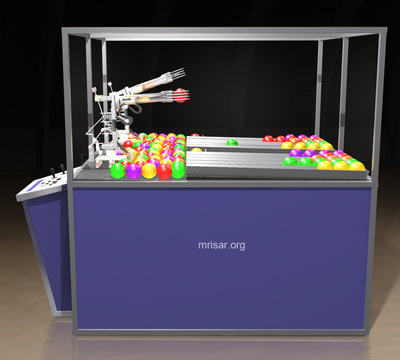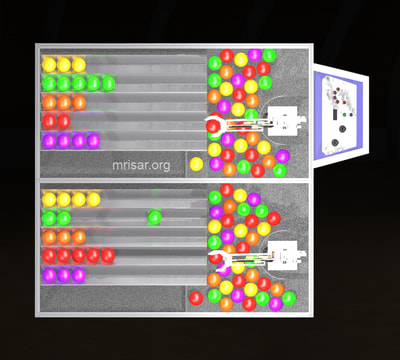MRISAR's Robotic Color Sorting Challenge Exhibit
Human vs. Robot!
|
Robotic Color Sorting Challenge Exhibit; Human vs. Robot! It can see colors. This exhibit relates to STEM education.
This exhibit has two robotic arms. One is operated by a robotic brain and the other is operated by a human user. The challenge is to see who is faster. The task is to sort colored balls into their areas during a timed interval. The exhibit keeps track of the time via a display counter. When the time is up who will have sorted more balls, the human or the robot? What the Robot does; Press the start button and the balls in the main activity area are agitated. As they work their way to the activity side ball retrieval collection point, the robot arm moves its hand over a ball and the color sensor located in the hand looks at it to determine the color. It then grasps the ball and moves it to the correct collection area for that specific color. As the remaining balls are agitated and move forward, the rest of the balls are sorted by the robot arm. When all of the balls are sorted into each correct color area path the robot arm resets to full up and back position and the entire sorted section of the activity automatically tips up and rolls the balls back to the unsorted activity area while agitating them into random placement for the next turn. What the User does; Uses the joysticks and finger push buttons to operate the robotic arm in order to pick up, move and sort the colored balls. The exhibit teaches elements of robotics, STEM based education, electrical and electromechanical engineering, photonics, optics, elements of the electromagnetic spectrum and to an extent an element of Chaos Theory. The exhibit can be made with your choice of laminate chosen from a standard selection which has many color options. This exhibit features two 39" long, nine range of motion, 5 finger electromechanical robot arms that are base mounted on the exhibit activity surface. The exhibit activity is totally encased by clear poly-carbonate that allows many people to view the exhibit while it is being operated. The electromechanical arms are designed in a totally open format, all the parts and the key components that operate them are visible for maximum educational merit. This relates to STEM education. The exhibit provides a unique format to study the engineering principles of a robot arm. The arms have pressure sensitive and end of travel limits, and can adapt to objects stacked in their path. Remote handling robots are used by industry, aerospace and commercial establishments to extend human capabilities in hazardous situations. Approximate size of exhibit is; 70" wide x 76" long (minus control panel) x 72" high. |

Terms: 7-year warranty against defects in our workmanship; Free Life-time phone/internet technical support; Life-time parts supply sourcing for our exhibits at reasonable prices. Contact us for price information.
Our Workmanship Quality! Our Terms and Warranty! Our Mission Statement! |





